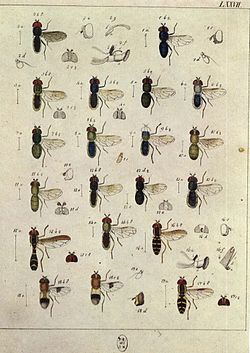| Psilota | |
|---|---|
 | |
| Psilota anthracina Figure 1 in Meigen Europäischen Zweiflügeligen | |
| Scientific classification | |
| Kingdom: | |
| Phylum: | |
| Class: | |
| Order: | |
| Family: | |
| Subfamily: | |
| Tribe: | |
| Genus: | Psilota Meigen, 1822 |
Psilota is a genus of small black hoverflies with long wings, from the family Syrphidae, in the order Diptera. They are one of the few hoverfly genera that do not have a vena spuria in the wings. [1] The larvae feed on tree sap. [2]